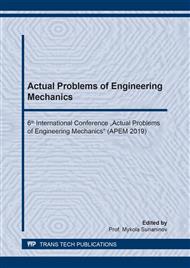[1]
V.V. Tiutiunyk, H.V. Ivanets, I.A. Tolkunov, E.I. Stetsyuk, System approach for readiness assessment units of civil defense to actions at emergency situations, Naukovyi Visnyk Natsionalnoho Hirnychoho Universytetu. 1 (2018) 99-105.
DOI: 10.29202/nvngu/2018-1/7
Google Scholar
[2]
M.I. Vasiliev, I.O. Movchan, O.M. Koval, Diminishing of ecological risk via optimization of fire-extinguishing system projects in timber-yards, Naukovyi Visnyk Natsionalnoho Hirnychoho Universytetu. 5 (2014) pp.106-113.
DOI: 10.29202/nvngu
Google Scholar
[3]
Y. Otrosh, A. Kovaliov, O. Semkiv, I. Rudeshko, V. Diven, Methodology remaining lifetime determination of the building structures, MATEC Web of Conferences. 230 (2018) 02023.
DOI: 10.1051/matecconf/201823002023
Google Scholar
[4]
Lakhani, Hitesh & Kamath, Praveen & Bhargava, Pradeep & Sharma, Umesh Kumar & Reddy, G Rami, Thermal Analysis of Reinforced Concrete Structural Elements, Journal of Structural Fire Engineering. 4 (2013) 227-244.
DOI: 10.1260/2040-2317.4.4.227
Google Scholar
[5]
Li Bai, Li & Song, Tao, Failure Analysis of Reinforced Concrete Columns after High Temperature, Applied Mechanics and Materials. 157-158 (2012) 1578-1581. 10.4028/www.scientific.net/AMM.157-158.1578.
DOI: 10.4028/www.scientific.net/amm.157-158.1578
Google Scholar
[6]
Zhang, X & Xiao, Yan & Kunnath, S.K., State of the art and prospect of research on fire resistance behavior of reinforced concrete columns. 24 (2015) 120-131. 10.13577/j.jnd.2015.0316.
Google Scholar
[7]
Dilek, Ufuk, Assessment of Fire Damage to a Reinforced Concrete Structure during Construction, Journal of Performance of Constructed Facilities - J PERFORM CONSTR FACIL. 21 (2007). 10.1061/(ASCE)0887-3828(2007)21:4(257).
DOI: 10.1061/(asce)0887-3828(2007)21:4(257)
Google Scholar
[8]
I. Korneeva, S. Neutov, M. Suriyaninov, Experimental studies of fiber concrete creep, MATEC Web of Conferences. 116 (2017) 02021.
DOI: 10.1051/matecconf/201711602021
Google Scholar
[9]
M. Surianinov, O. Shyliaiev, Calculation of plate-beam systems by method of boundary elements, International Journal of Engineering and Technology(UAE). 7(2) (2018) 238-241.
DOI: 10.14419/ijet.v7i2.23.11927
Google Scholar
[10]
A.F. Dashhenko, D.V. Lazareva, N.G. Sur'janinov, ANSYS v zadachah inzhenernoj mehaniki, Odessa, 2011 [in Russian].
Google Scholar
[11]
N.N. Fedorova, S.A. Val'ger, M.N. Danilov, Ju.V Zaharova, Osnovy raboty v ANSYS 17, Moskva, 2017 [in Russian].
Google Scholar
[12]
DSTU B V.1.1–20: 2007 Zakhyst vid pozhezhi. Perekryttia ta pokryttia. Metod vyprobuvan na vohnestiikist (EN 1365-2: 1999, NEQ). Kyiv, 2007 [in Ukrainian].
Google Scholar
[13]
DSTU B V.1.1–4–98* Zakhyst vid pozhezhi. Budivelni konstruktsii. Metody vyprobuvan na vohnestiikist. Zahalni vymohy. Kyiv, 2005 [in Ukrainian].
Google Scholar
[14]
V. Andronov, B. Pospelov, E. Rybka, Increase of accuracy of definition of temperature by sensors of fire alarms in real conditions of fire on objects, EasternEuropean Journal of Enterprise Technologies. 4 (5-82) (2016) pp.38-44.
DOI: 10.15587/1729-4061.2016.75063
Google Scholar
[15]
V. Andronov, B. Pospelov, E. Rybka, S. Skliarov, Examining the learning fire detectors under real conditions of application, EasternEuropean Journal of Enterprise Technologies, 3 (9-87) (2017) pp.53-59.
DOI: 10.15587/1729-4061.2017.101985
Google Scholar
[16]
DBN V.1.1-7:2016 (2017). Pozhezhna bezpeka obiektiv budivnytstva. Kyiv [in Ukrainian].
Google Scholar


